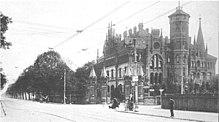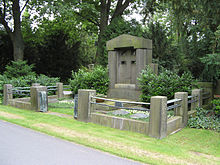Friedrich Willmer
Friedrich Willmer (born November 28, 1822 in Brünnighausen ; † July 7, 1908 in Hanover ) was a mill and wagon builder as well as a brick factory owner.
Life
Friedrich Willmer originally trained as a wheelwright or mill maker. 1837-1839 and 1842-1844 he attended the polytechnic school. From 1845 he learned machine and wagon construction at the Hanoverian wagon construction company Johann Ernst Dettmer at Heinrichstraße 40.
Willmer founded his own carriage factory for luxury carriages next to the district court, between Tivolistraße and Augustenstraße, which existed until 1905.
Friedrich Willmer married Auguste Dettmer (* July 12, 1824 - December 28, 1909), the daughter of his teacher Johann Ernst Dettmer (* September 20, 1789 - April 10, 1874). Her son Gustav (born May 13, 1852; † January 17, 1940) also attended the Polytechnic School, where he met the future architect Karl Börgemann .
In 1858 their father-in-law bought them a brickworks on Hildesheimer Chaussee, which Friedrich soon enlarged to 10 hectares. By 1877 he had increased production from one to 18 million stones. He supplied Ferdinand Wallbrecht with bricks for his tenements. He became a senator on the city council. In 1878 the Senate cobbled him the 600-year-old council brickwork in Engesohde, which had been in the city's possession for almost 500 years. Then the construction boom set in in Hanover.
In 1878 he became a member of the knighthood of the Calenberger Land , acquired the knighthood vote of the Luttmersen II estate and named his estate Döhren II .
In 1879, as a manor owner, he planned the construction of a castle-like mansion with the architect Karl Börgemann . In 1884 the Villa Willmer was built with 75 rooms, popularly known as the Tränenburg . In order to stand out from his competitor Carl Georg Fiedeler , he named his manor Waldhausen in 1894 .
After his death in 1908, the heirs sold the carriage factory premises to the state and in 1924 the Reichspost built the third largest postal check office in northern Germany after Berlin and Hamburg. This remained on Volgersweg until 1971, when it moved to the new building on Postkamp. His son continued to run the brick factory with increasing competition. Gustav bequeathed the villa and the property to his 3 daughters, who sold their inheritance piece by piece. The upper floor of the villa was destroyed in the Second World War. After that, the villa served as a shelter for the homeless for a long time. In 1970 the villa was sold to a building company that wanted to build a multi-storey apartment house on this site. The protest of the citizens against the demolition was of no use to city building officer Rudolf Hillebrecht , and in August 1971 the villa was razed to the ground.
literature
- Friedrich Lindau : Hanover. Reconstruction and destruction. The city in dealing with its architectural identity. 2nd Edition. Schlütersche, Hannover 2001, ISBN 3-87706-607-0 , pp. 221–241.
- Günther Porsiel: Die Willmer , 2005
- Waldemar R. Röhrbein : WILLMER, Friedrich. In: Dirk Böttcher , Klaus Mlynek, Waldemar R. Röhrbein, Hugo Thielen: Hannoversches Biographisches Lexikon . From the beginning to the present. Schlütersche, Hannover 2002, ISBN 3-87706-706-9 , p. 390 and others; online through google books
- Waldemar R. Röhrbein: Willmer, Friedrich. In: Klaus Mlynek, Waldemar R. Röhrbein (eds.) U. a .: City Lexicon Hanover . From the beginning to the present. Schlütersche, Hannover 2009, ISBN 978-3-89993-662-9 , p. 680.
Individual evidence
- ^ Waldemar R. Röhrbein : Willmer, Friedrich. In: Hannoversches Biographisches Lexikon . P. 390, online via Google Books
- ^ Karl Karmarsch: The Polytechnic School in Hanover. P. 275.
- ↑ Archive link ( Memento of the original from March 26, 2012 in the Internet Archive ) Info: The archive link was inserted automatically and has not yet been checked. Please check the original and archive link according to the instructions and then remove this notice.
- ^ Willmer family grave in Department 17, Engesohde City Cemetery , Hanover
- ↑ Archive link ( Memento of the original from March 24, 2012 in the Internet Archive ) Info: The archive link was inserted automatically and has not yet been checked. Please check the original and archive link according to the instructions and then remove this notice.
- ↑ Archive link ( Memento of the original from March 26, 2012 in the Internet Archive ) Info: The archive link was inserted automatically and has not yet been checked. Please check the original and archive link according to the instructions and then remove this notice.
- ↑ f. Lindau: Hanover: reconstruction and destruction ; P. 215
| personal data | |
|---|---|
| SURNAME | Willmer, Friedrich |
| BRIEF DESCRIPTION | Mill and wagon builders as well as brickyard owners |
| DATE OF BIRTH | November 28, 1822 |
| PLACE OF BIRTH | Brünnighausen |
| DATE OF DEATH | July 7, 1908 |
| Place of death | Hanover |

